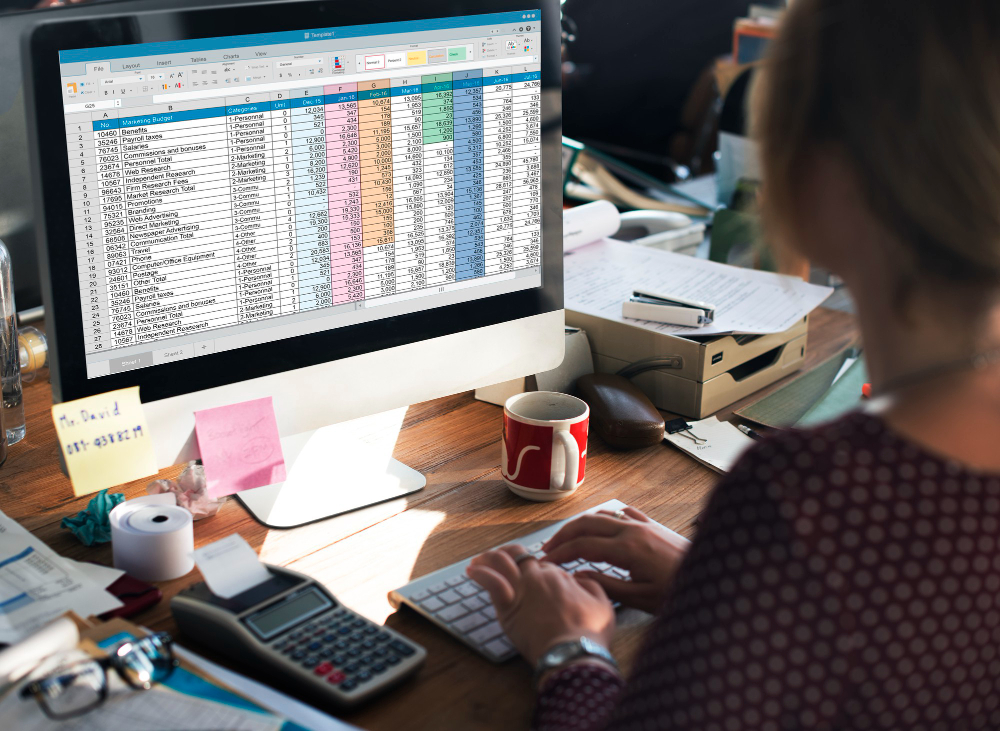
1. Introduction to General Ledger Accounting
General ledger accounting is a cornerstone for financial stability and decision-making when managing business finances. This foundational accounting process involves recording, organizing, and summarizing a company’s financial transactions. The general ledger functions as the “book of final entry,” where every financial transaction is recorded to reflect a business’s trustworthy financial standing. Centralizing all financial data simplifies financial management and accurately depicts the business’s financial health.
What is General Ledger Accounting?
General ledger accounting involves maintaining a record of all business transactions across various accounts, such as assets, liabilities, equity, revenue, and expenses. This comprehensive financial record is crucial for creating financial statements like the income statement, balance sheet, and cash flow statement.
The Importance of General Ledger in Business Finances
A well-organized general ledger is paramount for any business, regardless of size or industry. It offers a unified view of all financial data, making tracking spending, revenue, and profits easier. This, in turn, aids in making strategic decisions based on accurate financial insights.
2. Components of a General Ledger
Understanding the components of a general ledger is essential for comprehending how it operates to simplify business finances.
- Accounts Payable and Receivable: These accounts keep track of the money owed by the business and the money it is owed by others.
- Revenue and Expense Accounts: Revenue accounts record all incoming money, while expense accounts track outgoing funds.
- Equity, Assets, and Liabilities: These are the building blocks of a company’s financial position, showing what the business owns, owes, and the owner’s stake.
By meticulously managing these accounts, businesses can gain a holistic view of their financial status, making it easier to analyze performance and profitability.
3. The Role of a General Ledger Accountant
A general ledger accountant plays a critical role in maintaining the integrity and accuracy of the company’s financial data. This professional reconciles accounts ensures compliance with accounting standards, and prepares financial reports.
Key Responsibilities
1. Managing and reconciling general ledger accounts.
2. Reviewing journal entries and ensuring proper documentation.
3. Preparing monthly, quarterly, and annual financial statements.
Skills and Competencies Required
A competent general ledger accountant must possess strong analytical skills, attention to detail, and an in-depth understanding of accounting principles like GAAP (Generally Accepted Accounting Principles).
The Impact on Financial Health
With a general ledger accountant managing the financial data, businesses can ensure that their records are accurate and up-to-date, enhancing their financial health and compliance.
4. How General Ledger Accounting Streamlines Financial Management
One of the primary ways general ledger accounting simplifies business finances is by centralizing all financial data in one place. This consolidation ensures accuracy and eliminates redundancy. Here’s how it streamlines financial management:
Centralized Data for Improved Accuracy
Having all financial information in a single ledger reduces the risk of discrepancies and duplication. It provides a single source of truth for the business’s economic data, ensuring more accurate and reliable financial reporting.
Simplifying Financial Reporting
Creating financial reports becomes straightforward with a well-maintained general ledger. The data needed for income statements, balance sheets, and cash flow statements is readily available, saving time and reducing the risk of errors.
Ensuring Compliance and Reducing Errors
Maintaining an accurate general ledger helps ensure compliance with financial regulations and accounting standards. This reduces the likelihood of errors and helps avoid penalties during audits.
5. General Ledger vs. Sub-Ledger: Understanding the Difference
To fully appreciate the role of the general ledger, it’s essential to distinguish it from sub-ledgers.
The Hierarchical Structure
The general ledger serves as the primary ledger, while sub-ledgers provide a more detailed view of specific accounts such as accounts payable, accounts receivable, and payroll. Sub-ledgers feed data into the general ledger, ensuring that it reflects a comprehensive view of financial transactions.
How Sub-Ledgers Integrate with the General Ledger
Sub-ledgers simplify data management by categorizing transactions, which aggregate into the general ledger. This hierarchical structure helps in managing and analyzing financial data efficiently.
6. Automation in General Ledger Accounting
In today’s digital era, automation has become an invaluable tool in simplifying general ledger accounting.
Benefits of Automating General Ledger Processes
Automation eliminates manual data entry, reducing human errors and enhancing efficiency. Automated general ledger systems can also integrate with other financial software, enabling seamless data flow.
Popular Software Solutions
Many software solutions, such as QuickBooks, Xero, and SAP, offer general ledger functionalities, providing businesses with tools to manage their finances more effectively.
7. Financial Analysis and Decision-Making Using General Ledger Data
The general ledger is not just about recording transactions—it’s a powerful tool for financial analysis.
Extracting Insights from the General Ledger
Financial managers can leverage data from the general ledger to analyze trends, identify cost-saving opportunities, and track financial performance.
Using General Ledger Data for Forecasting and Budgeting
Accurate general ledger data is crucial for forecasting future financial performance and creating budgets. Businesses can use historical data to project future revenue, expenses, and profitability.
8. How General Ledger Accounting Reduces Business Costs
Avoiding Redundant Processes
By maintaining an organized general ledger, businesses can avoid redundant data entry and reduce administrative costs.
Optimizing Resource Allocation
General ledger accounting helps monitor resource allocation, ensuring that financial resources are used optimally.
9. Common Challenges in General Ledger Accounting
Despite its benefits, general ledger accounting is not without its challenges.
- Reconciling Accounts: Ensuring that all entries are accurate and there are no discrepancies between the general ledger and sub-ledgers.
- – Managing Multiple Entries: Businesses with high transaction volumes may find it challenging to manage numerous entries.
- Integrating with Other Financial Systems: Ensuring that the general ledger is compatible with systems like ERP or CRM can be complex.
10. Best Practices for Maintaining an Accurate General Ledger
To maintain an accurate and reliable general ledger, consider these best practices:
- Regular Reconciliation and Review: Reconcile accounts regularly to catch and correct discrepancies.
- Establishing Standardized Procedures: Implement standardized accounting procedures to ensure consistency and accuracy.
11. General Ledger and Regulatory Compliance
Ensuring Compliance with Accounting Standards (GAAP, IFRS)
Compliance is a critical aspect of general ledger accounting. Adhering to standards like GAAP or IFRS ensures that financial statements are accurate and legally compliant.
Role of the General Ledger in Audits
The general ledger provides auditors with a comprehensive record of all financial transactions, making it a vital tool for verifying financial data during audits.
12. Transitioning from Manual to Digital General Ledger Systems
Benefits of Digital Transformation
Digital systems enhance the accuracy and efficiency of general ledger accounting. They enable real-time data updates and reduce manual errors.
Steps for a Smooth Transition
1. Choose a software solution that aligns with your business needs.
2. Train staff on using the new system.
3. Migrate data carefully to ensure all historical records are preserved.
13. Real-world applications of General Ledger Accounting
General ledger accounting is used across various industries to maintain financial stability and transparency.
Case Studies from Various Industries
For example, in manufacturing, the general ledger helps track production costs and profitability, while in retail, it provides insights into inventory management and sales performance.
How Companies Leverage General Ledger Accounting to Enhance Profitability
Many companies use general ledger accounting to identify inefficiencies, streamline operations, and enhance profitability.
14. The Future of General Ledger Accounting
The future of general ledger accounting is bright, with emerging technologies set to revolutionize the field.
Emerging Trends
1. Artificial Intelligence (AI): AI can automate repetitive tasks and identify anomalies in financial data.
2. Machine Learning (ML): ML algorithms can provide predictive analytics, helping businesses accurately forecast financial trends.
The Role of Artificial Intelligence and Machine Learning
These technologies will play a crucial role in the future, enabling businesses to make more informed financial decisions based on real-time data analysis.
15. Frequently Asked Questions (FAQs)
Q1: What does a General Ledger Accountant do?
A general ledger accountant is responsible for maintaining and reconciling the general ledger, ensuring accuracy in financial records, and preparing financial statements.
Q2: Why is the general ledger called the “book of final entry”?
The general ledger is called the “book of final entry” because it contains a complete and finalized record of all financial transactions.
Q3: How does general ledger accounting help in tax preparation?
General ledger accounting simplifies tax preparation by providing accurate income, expenses, and deduction records, ensuring compliance with tax regulations.
Q4: What’s the difference between a general ledger and a trial balance?
The general ledger contains detailed entries of all transactions, while a trial balance is a report that lists the balances of each account to check for discrepancies.
Q5: How often should a general ledger be updated?
Depending on the volume of transactions, updating the general ledger daily or weekly is advisable.
Q6: Can small businesses benefit from general ledger accounting?
Yes, small businesses can greatly benefit from general ledger accounting, which helps them track financial health, prepare for taxes, and make informed decisions.
